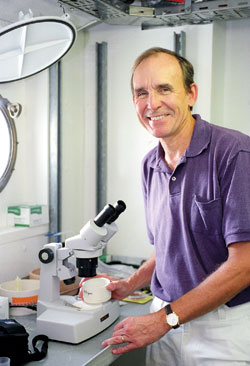Tiny life-forms have big impact on climate change

RESEARCH | It takes more than a million of them to fill a space the size of a pencil tip, but marine microbes play a big role in some of the environment’s most important processes.
These microscopic bacteria and plants living in the oceans are known to affect the carbon cycle, a complex series of exchanges that occur among the atmosphere, land and ocean. Carbon occurs naturally in the Earth’s atmosphere—mainly in its gaseous form, carbon dioxide—but certain human activities, such as the burning of fossil fuels, can contribute to increased levels of the gas, strengthening the “greenhouse effect” and the subsequent warming of the planet.
By studying microbes, scientists like David Kirchman, the Maxwell P. and Mildred H. Harrington Professor of Marine Studies, can better understand the carbon cycle and in turn learn more about climate change. Kirchman, an expert on the minuscule life forms, has traveled around the world to study them. This summer, he published a commentary in the Proceedings of the National Academy of Sciences discussing a new study on the genomes, or DNA sequencing, of microbes.
Kirchman describes a genome as like a blueprint or instruction book that provides “all the information for building life.” He notes that scientists in all fields of biology are focusing on genomes.
“Knowing the genome is the first step in understanding the biology of that organism,” he says. “It’s like a blueprint—you can’t say what the organism is doing [by knowing the genome], but it certainly outlines what’s possible as far as the types of processes it is able to do.”
Studying the genomes of microbes, he notes, involves looking for more basic information than studying human DNA.
“If you are looking at humans, you know lots about their biology already, like that they breathe air and walk on two feet on land. With marine microbes, you’re really looking for more basic information about what they do in the environment,” Kirchman says. “In humans you’re looking for extremely subtle differences between people, whereas for microbes you’re looking at cruder level—trying to figure out what they do.”
He says that understanding marine microbes is key to understanding the ocean. In turn, he says, “The ocean is an important part of the carbon cycle, and as we perturb it by adding more greenhouse gases, carbon dioxide and nitrous oxide being two of those, we need to know more about it….One kind of microbe, phytoplankton, takes out carbon dioxide from the atmosphere, and the other kind, heterotrophic microbes, puts it back in.
“We and other animals are also heterotrophs, meaning we burn organic carbon to make energy, but heterotrophic microbes are more numerous than humans and other animals and thus important in the carbon cycle.”
Scientists need to understand the balance between the two types of microbes, Kirchman says, because that balance helps determine how much carbon can be soaked up by the oceans.
“More carbon in the oceans means less in the atmosphere and a smaller contribution to climate change,” he says. “But higher carbon inputs into the oceans also are causing the oceans to be more acidic, and that’s not good.”
Article by Elizabeth Boyle





